IN THIS ISSUE
- Mudpuppy surprise
- Winter aid for insects
- How we manage smoke
- Radio-tracking red knots
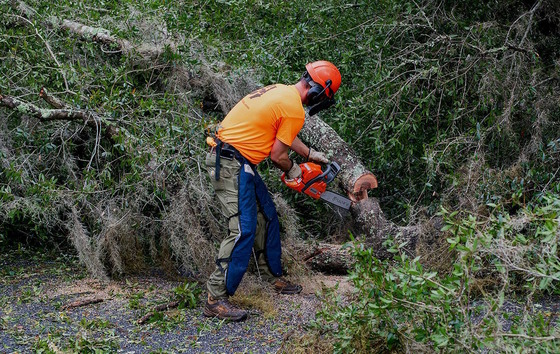 DNR staff saw a downed tree on a south Georgia road (DNR)
After Hurricane Helene plowed through Georgia, DNR worked 24-7 in coordination with other agencies to clear roads, ensure public safety and help Georgians statewide recover from the massive storm.
For glimpses into that effort, see the Wildlife Resources Division's Facebook and Instagram pages, as well as the social media accounts of sister divisions, including Law Enforcement, State Parks and Historic Sites, and Coastal Resources.
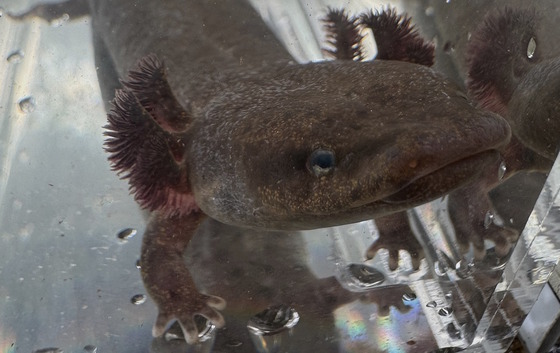 Mudpuppy mugs for the camera (Tyler Troxel/DNR)
By THOMAS FLOYD
Hellbender surveys this summer turned up a welcomed surprise: one of the state’s few sightings of common mudpuppies.
Although these big freshwater salamanders also known as waterdogs range from New York to the Great Lakes and from southern Canada to the rivers of northern Mississippi, Alabama and Georgia, common mudpuppies are abundant in only parts of that realm. And in Georgia, they are rare.
The mid-August capture and release of three mudpuppies near Blairsville marked only the third time that Necturus maculosus has been documented in the state. (The previous sightings were near Ringgold in 1987 and McCaysville in 2010.)
While mudpuppies are found alongside eastern hellbenders throughout much of the hellbender’s range, it’s unclear why mudpuppies are so elusive or simply absent in many streams in western North Carolina and Georgia.
Since 2011, DNR surveys have recorded nearly 900 hellbenders across the Tennessee River drainage in north Georgia. But during that same time, and in what is the state's presumed distribution of mudpuppies, three waterdogs have been seen.
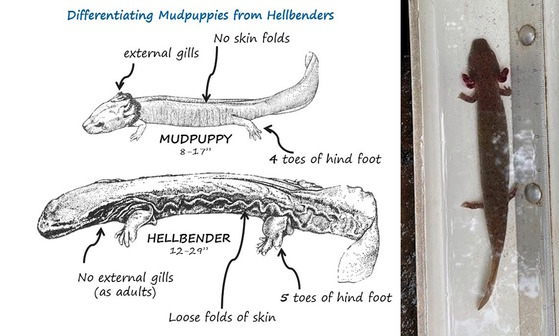 One of the Blairsville waterdogs (right) and how to tell them from hellbenders (Thomas Floyd/DNR)
MUDPUPPY LOVE
- Some say the mudpuppy’s squeaking or squealing noises sound like a dog’s bark, leading to the canine common names for this salamander.
- Mudpuppies can grow over a foot long and live 20-plus years – all of it spent in the water.
- Even as adults, they keep their larval characteristics, including the feathery, rose-colored gills on their head. The size of the gills depends on the oxygen content in the water.
- Mudpuppies prowl rivers, lakes and other fresh waters at night, scarfing up any aquatic animals they can swallow, from snails to crayfish. They’ll also eat carrion. In turn, they are prey for larger animals, such as snakes and fish.
- These amphibians are harmless. They also pose no threat to fish populations.
- Mudpuppies have sensitive skin and, like hellbenders, can be indicators of water quality.
- Anglers who hook one should release it unharmed. Please also report mudpuppy sightings to DNR.
Thomas Floyd is a wildlife biologist with DNR’s Wildlife Conservation Section.
 Mourning cloak butterflies often winter in woodpiles and under tree bark. (Adobe Stock)
By TERRY W. JOHNSON
More Georgians than ever are trying to encourage pollinators and other beneficial insects in their yards. Most of the focus is on planting native and even ornamental plants that provide nectar and pollen for pollinators, and sometimes even serve as host plants for butterflies and moths.
Yet, while this effort is undoubtedly helping, much more can be done to bolster native bees and other such insects. I’m referring to providing overwintering and nesting sites for these important members of the insect community.
With autumn here and winter closing in, there are even ways you can adjust your seasonal yardwork to easily help supply some of these habitat needs. ...
Read Terry’s column for tips on helping native insects in your yard this fall.
Terry W. Johnson is a retired DNR manager and executive director of TERN, friends group of the Wildlife Conservation Section. Check out past columns and his blog. Permission is required to reprint a column.
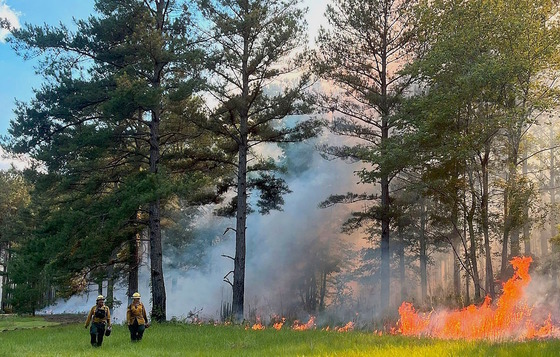 DNR staff managing a prescribed burn at George L. Smith State Park (Shan Cammack/DNR)
By SHAN CAMMACK
With the winter season for prescribed fire just around the corner, it helps to know that fire is a key ecological process that has shaped natural communities across Georgia and the Southeast for eons.
Almost half of the 472 plant species listed in Georgia’s State Wildlife Action Plan depend on or benefit from fire. And that’s not counting the native animals – gopher tortoises, bobwhite quail and others – that also fit that description.
Prescribed fire is a safe way to apply a natural process, ensure ecosystem health and reduce wildfire risk by limiting the build-up of fuels that can feed wildfires. In lowering that risk, prescribed fire also keeps our air cleaner. Smoke from wildfires is typically higher in volume and pollutant levels and can last for weeks or months. Smoke from prescribed fires, often called controlled burns, is managed and usually lasts only a day or two.
Where there’s fire, there’s smoke. But as managers of prescribed fires, we take great care to manage the smoke. We follow practices that help minimize impacts on smoke-sensitive areas, such as schools, hospitals, cities and busy roads. We also consider the airshed (the geographical area within which the air is usually confined or channeled), check regional air-quality monitors and burn when appropriate for clean air in local communities.
Before a burn, we choose weather parameters that help us meet burn objectives and effectively manage the smoke. The Fire Weather Dashboard is our go-to for fire-related forecasts. We also use tools like VSmoke and the Georgia Winds and Air Quality Map to minimize smoke impacts. Each fall, fire training "refresher" sessions emphasize these topics, along with lessons learned from the previous burn season.
During burns, we check weather conditions at the site and light the fire in a way that gets the smoke up and out.
After burns, we monitor to make sure the fire is out and there are no lingering smoke issues. Still-burning fuels are mopped up, squelching smoke near firebreaks.
The net result is a plus for wildlife, habitats and people. Using prescribed fire, burn managers help enrich biodiversity, build resilient ecosystems and promote cleaner air.
 Growing-season burn on Sandhills WMA: West in middle Georgia (Hal Massie/DNR)
SEEING SMOKE?
Visit AirNow to learn about air quality in your area and ways to stay safe.
RECORD YEAR
During the fiscal year that ended June 30, DNR’s Wildlife Resources Division applied prescribed fire to nearly 96,700 acres, a new high for the agency and all contributing to healthier wildlands and wildlife populations.
FIRE RESOURCES
Shan Cammack is fire management officer for DNR’s Wildlife Conservation Section.
 Red knots on Georgia's Ogeechee Bar in spring (Fletcher Smith/DNR)
Twelve of 13 red knots tracked by satellite transmitters this spring from Little Tybee Island to their Arctic breeding grounds flew straight from Georgia to those remote areas in Canada. The findings by DNR and partners underscored previous research profiling the Southeast – and the food resources such as horseshoe crab eggs the region's coastline provides – as a crucial stopover for many of these robin-sized migrants that wing it 9,000-plus miles between South America and the Arctic every spring and fall.
DNR’s Wildlife Viewing Grants Program is accepting proposals for 2025, and the new round has raised the per-proposal grant cap to $5,000 for work to help people experience native Georgia wildlife. Details and an interactive map of previous projects at georgiawildlife.com/WildlifeViewingGrants.
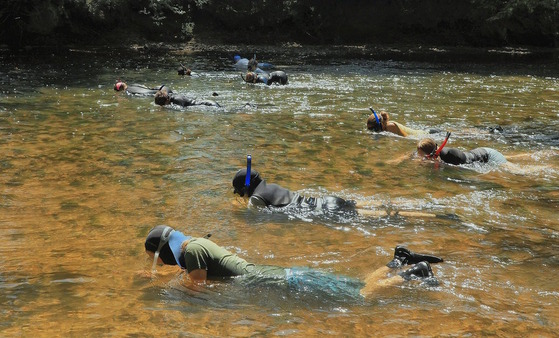 Mussel survey on the Conasauga River (Alan Cressler)
By scuba, snorkel and hand, recent mussel surveys from the Conasauga and Savannah rivers to southwest Georgia’s Spring Creek collected data on a number of rare species. The work not only highlighted the continuing recovery of Spring Creek – over 3,500 mussels found this summer compared to about 600 after drought sapped the region 2010-11 and Hurricane Michael rolled through in 2018 – it also helped create a monitoring protocol for mussels and snails on the Conasauga.
With four Argentine black and white tegus killed or found dead in Toombs and Tattnall counties this year, and a handful more seen, area residents are asked to report any tegus in the wild (“Sightings spike,” July). The big, invasive lizards, which have established a wild population in the rural counties, are usually more active in the fall before going into brumation, the reptile version of hibernation.
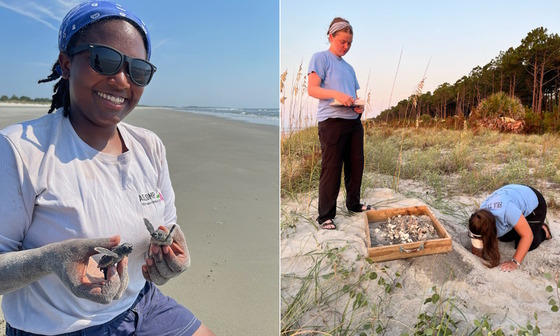 Snapshots from the loggerhead nesting season: checking hatchlings, inventorying nests (DNR)
Call it a wrap for loggerhead sea turtle nesting on Georgia’s coast. The 2024 season included at least 2,490 nests, better than the 35-year annual average (1,642) but far shy of the record 4,071 nests in 2022. This summer's hatching success rate of 46 percent came in under the 10-year average of 63 percent largely because of heavy rain and tidal inundation from Tropical Storm Debby. Georgia Sea Turtle Cooperative members inventory nests to estimate the number of hatchlings produced, data critical for assessing the loggerhead population. More details.
A rough-and-tumble tactic is helping the native groundcover nursery at Altama Plantation Wildlife Management Area near Brunswick score higher germination rates for legumes. To mimic seeds being eaten by animals and passed through their digestive system – a vital step for some plant seeds – staff are using rock tumblers to weaken and open the seed coatings and help the seeds absorb water.
 Black witch moth near Lilburn (Rick Krause)
Quick hits:
- Terry W. Johnson’s “Out My Backdoor” column about black witch moths spurred reports of other sightings, including the black witch above photographed by Rick Krause at his Lilburn-area home this summer.
- Two Clymene dolphins that stranded dead at Cumberland Island last month marked Georgia’s first record of this dolphin species normally found in the deep, tropical waters of the Atlantic.
- Another first: A butterfly hike and survey at Smithgall Woods State Park was DNR's first combo of the annual survey and an education program, with some 20 adults and youth learning how to identify and log species on iNaturalist.
- The practice and promise of cross-fostering red-cockaded woodpeckers (“Woodpecker swap,” June) is explained in this Tall Timbers e-news article.
- It's time for fall native plant sales: The State Botanical Garden of Georgia’s is Oct. 10-12 and the Georgia Native Plant Society provides details on others.
- When a young broad-winged hawk attacked a three-toed box turtle in Missouri, the turtle pulled into its shell, unintentionally trapping the hawk by its talons and requiring human help to free both.
- The Give Wildlife a Chance Poster Contest offers teachers and K-fifth graders the chance to celebrate wildlife through art, with this year’s “Colors of the Wild: Blend In or Stand Out” theme exploring nature's hues and patterns.
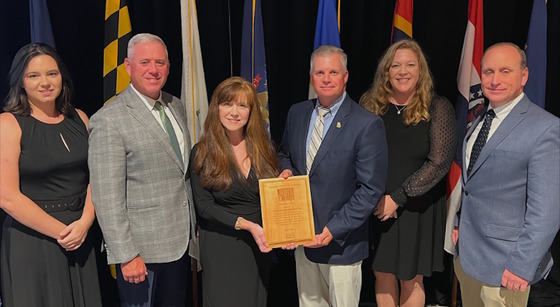 Parks Director Angie Johnson (left/center), DNR Commissioner Walter Rabon (right/center) and other DNR leaders
Names in the news: DNR’s State Parks and Historic Sites Division received the National Association of State Parks Directors’ Innovation Award for its efforts to increase accessibility, including to campsites, docks and kayak launches through the DNR Outdoors Beyond Barriers program and via a partnership with the Aimee Copeland Foundation’s All Terrain Georgia to place Action Trackchairs at 20 park properties. Dr. J. David Allen, founding chair of the Georgia Natural Resources Foundation, died at age 79 on Aug. 9. A skilled oral and maxillofacial surgeon, Allen was also a leader in a wide range of Atlanta-area organizations, from Emory University and the Georgia Chamber of Commerce to Zoo Atlanta and the Georgia Historical Society. Garden & Gun named Blairsville’s Becky Griffin one of the magazine’s 2024 Champions of Conservation for developing the Great Southeast Pollinator Census, a citizen science project started as a pilot program in Georgia schools and now an annual multistate collection of pollinator data.
WHAT YOU MISSED ...
In the previous Georgia Wild:
- Rare plants BOLO
- Black witch moths
- Seeing spotted skunks
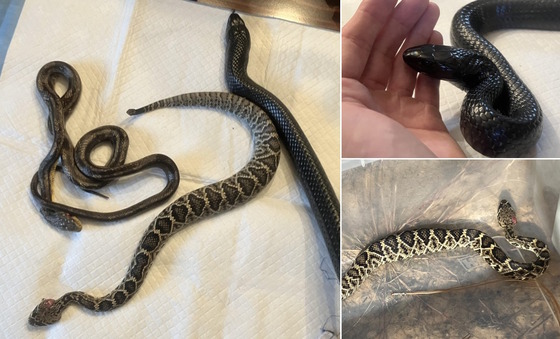 Indigo snake and its dead -- and live -- meals (Matt Moore/DNR)
"Indigo snake vomited up two snakes, one came out alive," IFLScience. Related coverage: Fox Weather, BBC, New York Post, National Geographic Spain and others.
(+video) "New threat at Georgia lakes: mystery snails," WXAI-TV (ch. 11, Atlanta)
"DNR asks for help finding threatened plant," WSAV-TV (Savannah)
"'Committee' of vultures settles, briefly, in Northlake," Statesboro Herald
"County rejects $300M solar farm beside vital bear habitat," Atlanta Journal-Constitution
"Rare whale died of chronic entanglement in Maine fishing gear," The Associated Press. Other North Atlantic right whale coverage: "Aquarium spots dozens of right whales off Long Island" (WFXT-TV, Boston), "Entangled whale in Gulf of St. Lawrence" (Canadian Broadcasting Corp.), "Go slow, whales below" (SaportaReport), "Experimental edge of fishing tech: ditching ropes" (Undark).
"DNR ups grants promoting wildlife viewing," Bryan County News and others
"Feed me: Georgia's carnivorous plants," Georgia Magazine
"Rare firefly found at UGA’s State Botanical Garden," Morning Ag Clips
"Effingham County man reports tegu lizard in wild," The Georgia Virtue
"Give Wildlife a Chance Poster Contest open to students," WSAV-TV (Savannah) and others
(+video) "Old railcars used as artificial reefs," The Weather Channel
"As Carter turns 100, historian recounts hunt with former president," 9&10 News (Traverse City, Mich.)
"How social media is putting rarest wildlife at risk," The Guardian (London) (study in Science of the Total Environment)
"Florida announces results, winners of Python Challenge," Florida FWC
"Invasive animals plague S.C.," The Post and Courier (Charleston, S.C.)
"Bald eagle rescued in Missouri was too fat to fly," KCPQ-TV (ch. 13, Seattle)
(audio) "Federal grant to fund crayfish conservation in N.C.'s coastal plains," WFDD-FM (88.5, Winston-Salem, N.C.)
"Examining Effects of Body Size on Right Whale Birth Rates," NOAA
(audio) "Dr. Rich Seigel and Long-term Snake Research," Orianne Society "Snake Talk" podcast
"Biodiverse Washington," Washington Department of Fish and Wildlife
Top
|